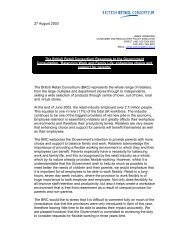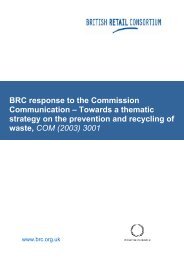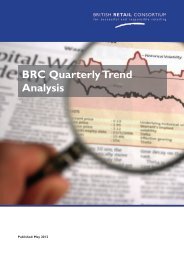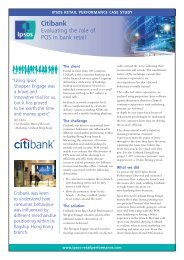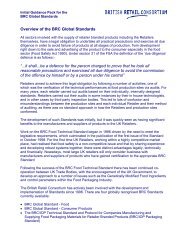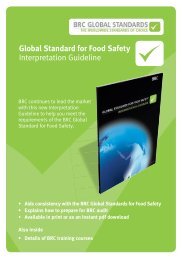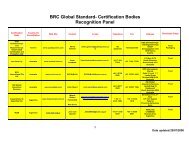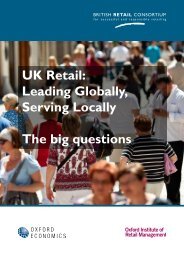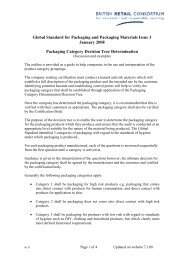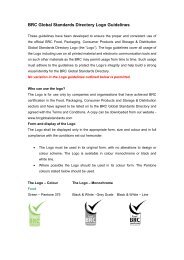BRC BRC GLOBAL STANDARDS
BRC BRC GLOBAL STANDARDS
BRC BRC GLOBAL STANDARDS
You also want an ePaper? Increase the reach of your titles
YUMPU automatically turns print PDFs into web optimized ePapers that Google loves.
<strong>BRC</strong> <strong>GLOBAL</strong> <strong>STANDARDS</strong><br />
THE WORLDWIDE <strong>STANDARDS</strong> OF CHOICE<br />
INTRODUCTION TO THE <strong>BRC</strong><br />
The Global Standard for Food Safety was first developed<br />
in 1998 by UK retailers to enable their suppliers to be<br />
audited by third party Certification Bodies against a<br />
single consistent standard, reducing duplication of effort<br />
and enabling retailers to focus activities on areas of<br />
competitive advantage. Built on the principles of clear<br />
risk-based requirements, informative report format and<br />
auditor competence, the Standard has continued to<br />
develop and evolve with input from a wider base of<br />
international stakeholders including retailers, food<br />
service companies, food manufacturers and Certification<br />
Bodies.<br />
The Standard is closely managed by the <strong>BRC</strong> who license<br />
the use of the Standard to Certification Bodies who must<br />
be both accredited by their national Accreditation Body<br />
and abide by strict <strong>BRC</strong> requirements for auditor<br />
competency, reporting and performance.<br />
The Standard changed from an inspection to a<br />
certification standard in 2000 introducing increased<br />
responsibilities for the Certification Bodies in terms of<br />
the award of certificates and ensuring ongoing<br />
compliance to the Standard by certificated sites for the<br />
duration of the certificate.<br />
<strong>GLOBAL</strong> FOOD SAFETY<br />
INITIATIVE (GFSI)<br />
The <strong>BRC</strong> Global Standard for Food Safety was the first<br />
standard to be approved by the GFSI as part of their<br />
process for mutual recognition of food safety standards<br />
and continues to be the most widely used of the GFSI<br />
standards with over 9,000 certificated sites worldwide.<br />
THE <strong>BRC</strong> <strong>GLOBAL</strong> STANDARD FOR<br />
FOOD SAFETY<br />
• Designed to help ensure manufacturers are<br />
achieving high levels of food safety and product<br />
quality management and meeting all legal food<br />
safety requirements.<br />
• Based on HACCP principles and supported by the<br />
need for documented quality management<br />
systems. The standard includes detailed and<br />
prescriptive requirements covering the factory<br />
environment, hygiene/sanitation, foreign body<br />
and process controls, training and control of<br />
personnel.<br />
• Requirements which are considered to be crucial<br />
to the establishment and operation of an<br />
effective food quality and safety system are<br />
highlighted as “Fundamental” and given special<br />
emphasis.<br />
THE FOOD STANDARD HAS BEEN<br />
FULLY REVISED AND REISSUED IN<br />
JANUARY 2008 TO INCORPORATE<br />
THE LATEST DEVELOPMENTS IN<br />
FOOD SAFETY.<br />
The new Standard places greater emphasis on management<br />
commitment and review to promote sustainable standards.<br />
Emerging issues such as allergen management and security<br />
are covered in detail.<br />
Emphasis on management of product identity ensures where<br />
raw materials are used with specific claims e.g. ‘Farm<br />
Assurance’, ‘origin’ or ‘Organic’ there are systems to maintain<br />
product identity.<br />
Certificates are only issued when all non-conformities<br />
identified during an audit are proven to have been effectively<br />
resolved – providing confidence to users of that manufacturer.<br />
Certificates are graded A to C allowing differentiation between<br />
the better and least prepared manufacturers.<br />
Audit frequency is linked to performance with sites awarded a<br />
Grade A or B receiving annual audits and Grades C six monthly<br />
audits.<br />
A new voluntary unannounced audit program introduced with<br />
issue 5 enables the best suppliers to demonstrate the maturity<br />
of their food safety systems.<br />
Audit reports include:<br />
• Site summary providing all key audit information and<br />
company profile.<br />
• Non-conformance report including comment on action<br />
taken and evidence provided to resolve the nonconformity.<br />
• Detailed report providing bullet point commentary on<br />
how each requirement has been addressed by the site.<br />
RIGOROUS AND EXHAUSTIVE<br />
MANAGEMENT OF <strong>STANDARDS</strong><br />
Certification Bodies using the schemes must be contracted<br />
with the <strong>BRC</strong> and Accredited to ISO Guide 65 (EN 45011).<br />
Certification Body requirements documents lay out the<br />
detailed requirements which must be met by all Certification<br />
Bodies auditing to the <strong>BRC</strong> Global Standards.<br />
All auditors must meet the stringent competency,<br />
qualification and experience requirements and successfully<br />
complete Standard specific training courses before<br />
acceptance by the <strong>BRC</strong>.<br />
All auditors must be registered with the <strong>BRC</strong> and reports<br />
will only be accepted from registered auditors.<br />
All audit reports and certificates must be submitted to the<br />
<strong>BRC</strong> and will be sampled to ensure quality and consistency.<br />
A referral process enables any issues about audit standards<br />
to be identified, reported and thoroughly investigated.




